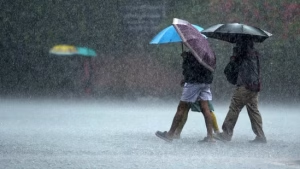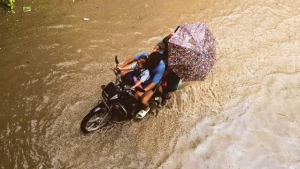Uttar Pradesh – In a tragic turn of events, devastating storms in Uttar Pradesh have claimed at least 22 lives over the past 48 hours. The severe weather system, characterized by intense rainfall, thunderstorms, and strong winds, has swept through nearly half of the state’s 75 districts, leaving a trail of destruction in its wake. The devastating storms in Uttar Pradesh have also damaged crops, livestock, and houses, compounding the suffering of residents already reeling from a recent heatwave.
The India Meteorological Department (IMD) has attributed these devastating storms in Uttar Pradesh to the collision of Westerly and Easterly winds originating from the Arabian Sea and the Bay of Bengal, respectively. Weather experts warn that these dangerous conditions could persist for at least three more days, raising concerns about further casualties and property damage.
Weather Patterns Behind the Devastating Storms in Uttar Pradesh
The sudden change in weather conditions leading to devastating storms in Uttar Pradesh represents a classic case of conflicting weather systems. According to meteorological experts, the state is currently experiencing the effects of a powerful convergence of air masses. The Westerly winds from the Arabian Sea and Easterly winds from the Bay of Bengal have collided over the region, creating perfect conditions for violent thunderstorms.
“What makes these devastating storms in Uttar Pradesh particularly dangerous is the rapid transition from heatwave conditions to severe thunderstorms,” explained Dr. Rajesh Kumar, a senior meteorologist at the IMD. “Such abrupt changes give people little time to prepare or take adequate shelter.”
The IMD recorded wind speeds reaching approximately 48 kilometers per hour in Agra in western Uttar Pradesh, while Prayagraj and Gorakhpur in eastern parts of the state experienced gusts of around 43 kilometers per hour. These powerful winds associated with the devastating storms in Uttar Pradesh have uprooted trees, damaged power lines, and caused structural damage to buildings across affected districts.
Death Toll and Human Impact of the Devastating Storms in Uttar Pradesh
The devastating storms in Uttar Pradesh have resulted in at least 22 confirmed fatalities over a short 48-hour period. Local authorities have reported that most deaths occurred due to lightning strikes, falling trees, and collapsed structures. The victims span various age groups and come from different socioeconomic backgrounds, highlighting the indiscriminate nature of such natural disasters.
“We are deeply saddened by the loss of lives due to these devastating storms in Uttar Pradesh,” stated Chief Minister Yogi Adityanath during an emergency press briefing. “The state government has mobilized all available resources to provide immediate relief to affected families and prevent further casualties.”
The devastating storms in Uttar Pradesh have disproportionately affected rural communities, where housing structures are often less resilient to extreme weather events. Reports indicate that numerous villagers were caught unaware while working in fields or traveling between locations when the storms intensified.
Agricultural Devastation Caused by the Storms
Beyond the tragic loss of human life, the devastating storms in Uttar Pradesh have dealt a severe blow to the state’s agricultural sector. Uttar Pradesh, often referred to as India’s breadbasket, relies heavily on agriculture for its economic stability and food security.
Early assessments suggest that the devastating storms in Uttar Pradesh have damaged thousands of hectares of standing crops. Wheat, mustard, and vegetable crops that were nearing harvest have been particularly affected, with some farmers reporting complete destruction of their seasonal yield.
“I had invested my entire savings in this season’s wheat crop,” lamented Ram Prasad, a farmer from Bahraich district. “The devastating storms in Uttar Pradesh have flattened everything. I don’t know how my family will survive the coming months.”
Livestock losses have further compounded the economic impact of these devastating storms in Uttar Pradesh. Numerous cattle, goats, and poultry have perished due to lightning strikes or collapsing structures, representing significant financial losses for rural households that depend on animal husbandry for supplementary income.
District-wise Impact of the Devastating Storms in Uttar Pradesh
The devastating storms in Uttar Pradesh have affected approximately 37 districts across the state, with varying degrees of intensity. Western districts including Agra, Mathura, and Aligarh reported significant property damage due to high-velocity winds, while eastern districts such as Gorakhpur, Prayagraj, and Varanasi experienced more intense rainfall and lightning activity.
Reports from Bahraich and Lakhimpur Kheri districts indicate that hailstorms accompanying the devastating storms in Uttar Pradesh caused extensive damage to crops and vehicles. Hailstones, some reportedly as large as golf balls, pummeled agricultural fields and damaged the roofs of numerous houses.
“The devastating storms in Uttar Pradesh hit our village around midnight,” recounted Sunita Devi from Lakhimpur Kheri. “The sound of hail hitting our roof was terrifying. By morning, our entire wheat field looked like it had been flattened by a roller.”
Emergency Response to the Devastating Storms in Uttar Pradesh

In response to the devastating storms in Uttar Pradesh, state authorities have activated emergency protocols across affected districts. The State Disaster Response Force (SDRF) has deployed teams to conduct rescue operations and assist in the evacuation of residents from high-risk areas.
The Chief Minister’s office has announced compensation of ₹400,000 ($4,800) for the families of each deceased victim of the devastating storms in Uttar Pradesh. Additionally, financial assistance will be provided to those who have lost homes or suffered significant property damage.
“Our priority is to ensure that relief reaches every person affected by these devastating storms in Uttar Pradesh,” stated Suresh Kumar Khanna, the state’s Finance Minister. “We have released emergency funds to district administrations to expedite the distribution of aid.”
Healthcare Challenges Amid the Crisis
The devastating storms in Uttar Pradesh have placed additional strain on the state’s healthcare infrastructure. Local hospitals and primary health centers have reported an influx of patients suffering from injuries related to the storms, including fractures, lacerations, and concussions.
Medical professionals are also concerned about potential disease outbreaks following the devastating storms in Uttar Pradesh. Standing water resulting from heavy rainfall can become breeding grounds for mosquitoes, increasing the risk of vector-borne diseases such as dengue and malaria.
“We are setting up medical camps in areas worst affected by the devastating storms in Uttar Pradesh,” explained Dr. Anita Singh, Director of Health Services. “These facilities will provide immediate medical attention to injured individuals and preventive care to mitigate the risk of post-disaster diseases.”
Infrastructure Damage Assessment
The devastating storms in Uttar Pradesh have caused significant damage to the state’s infrastructure. Preliminary reports indicate that hundreds of electricity poles have been uprooted, resulting in widespread power outages across affected districts. Restoration efforts are underway, but authorities estimate that it could take several days to fully restore electricity to all affected areas.
Road networks have also suffered damage due to the devastating storms in Uttar Pradesh. Fallen trees and debris have blocked numerous highways and rural roads, hampering relief efforts and complicating emergency vehicle movement. Public Works Department teams are working around the clock to clear obstructions and restore transportation links.
“The devastating storms in Uttar Pradesh have damaged approximately 320 kilometers of roads and 28 small bridges,” reported the state’s Infrastructure Development Commissioner. “Our teams are prioritizing the clearing of main arterial routes to facilitate the movement of emergency services.”
Meteorological Forecast and Ongoing Threat
The IMD has issued continued alerts regarding the devastating storms in Uttar Pradesh, predicting that similar weather conditions could persist for at least three more days. Citizens have been advised to remain vigilant and take necessary precautions to protect themselves and their property.
“These devastating storms in Uttar Pradesh represent a complex weather system that is likely to continue affecting the region through the weekend,” stated an IMD spokesperson. “We recommend that residents stay indoors during thunderstorms, avoid open areas during lightning activity, and secure loose objects that could become dangerous projectiles in high winds.”
Weather radar images suggest that the devastating storms in Uttar Pradesh could shift eastward in the coming days, potentially affecting neighboring states such as Bihar and parts of West Bengal. Regional meteorological offices are coordinating to provide timely warnings to populations in the projected path of the storm system.
Government Responses
The Uttar Pradesh government has swiftly initiated emergency measures to address the devastation caused by the recent spate of heavy rain and thunderstorms. Over the past two days, the state has recorded at least 22 fatalities due to severe weather events, which have also destroyed homes, crops, and livestock in nearly half of the state’s districts. In response, the state administration has activated relief and rescue operations across the affected regions.
Chief Minister Yogi Adityanath held an emergency meeting with senior officials and directed all district magistrates to remain on high alert. Authorities have been instructed to carry out damage assessments and submit immediate reports to facilitate the disbursement of compensation. The Chief Minister has announced ex-gratia payments of ₹4 lakh to the families of the deceased. Financial assistance for damaged properties and crop losses is also being organized under the State Disaster Response Fund (SDRF).
State-level disaster response teams, in coordination with the National Disaster Response Force (NDRF), have been deployed to severely affected districts. Relief camps have been set up in low-lying areas to shelter displaced individuals, and efforts are underway to restore electricity, clear roads, and repair water supply systems. The state government is also working with agricultural departments to evaluate crop losses and prepare support for farmers, including possible insurance claims.
In addition, weather advisories are being broadcast regularly to warn residents of potential risks over the next three days. The Meteorological Department has forecast further rainfall and thunderstorms, prompting the government to extend its alert and readiness for emergency response. School closures have been announced in vulnerable districts, and medical teams have been put on standby to deal with weather-related health emergencies.
The state leadership has appealed to the central government for additional assistance and funding, particularly for long-term rehabilitation and infrastructure repair. Union ministers have expressed concern and assured all possible support. Meanwhile, the Uttar Pradesh Relief Commission is compiling detailed data from each district to streamline aid distribution and track the progress of relief efforts.
These coordinated steps reflect the urgency and seriousness with which the government is addressing this crisis. Officials continue to monitor developments closely as weather conditions remain unstable.
Public and Community Reactions
As severe weather continues to lash Uttar Pradesh, residents across the state are grappling with loss, uncertainty, and growing fear. With at least 22 lives lost and widespread damage to homes, livestock, and crops, public sentiment is marked by anxiety and frustration. Communities in the worst-hit districts are struggling to cope with immediate needs such as shelter, food, and medical aid.
In rural areas, where agriculture is the mainstay of livelihoods, the destruction of standing crops has led to despair among farmers. Many expressed concerns about repaying loans and surviving without any harvest income. Local farmer groups are urging the government to provide direct compensation and support through crop insurance schemes. Some have also demanded a temporary waiver on agricultural loans due to the unforeseen calamity.
Residents of partially submerged villages and damaged homes are now taking shelter in temporary relief camps or with neighbors. Many are relying on community support and volunteer-led distribution of food and essentials. Local NGOs and youth groups have mobilized quickly, offering assistance in cleaning debris, rescuing stranded individuals, and delivering basic supplies in areas yet to receive formal aid.
Social media platforms have become a key tool for residents to share real-time updates, appeal for help, and highlight areas that remain neglected by official rescue efforts. Hashtags calling for immediate relief in certain districts have trended locally, prompting quicker responses from authorities. However, some citizens have criticized the slow pace of aid distribution in remote villages, citing delays in compensation and inadequate relief materials.
Despite the hardships, stories of resilience and unity have emerged. In multiple districts, community kitchens have been set up by volunteers to feed those displaced. Neighbors have opened their homes to the stranded, and local businesses are donating supplies to help affected families.
At the same time, the uncertainty over continued bad weather is adding to the mental stress of the public. Parents are worried about their children’s safety, especially with schools temporarily shut. In towns and cities, erratic power supply and water shortages are compounding the public’s woes.
While there is appreciation for the government’s emergency actions, many citizens are demanding a more proactive, long-term disaster preparedness plan. As storms are expected to persist, the public remains watchful, hopeful that the worst is over and that rebuilding can begin soon.
Climate Change Context and Increasing Weather Extremes

Meteorologists and climate scientists are analyzing whether the devastating storms in Uttar Pradesh reflect broader patterns of climate change affecting the Indian subcontinent. While individual weather events cannot be directly attributed to climate change, experts note that the frequency and intensity of extreme weather events have increased in recent decades.
“The devastating storms in Uttar Pradesh exemplify the kind of weather whiplash that climate models have predicted for this region,” explained Dr. Priya Sharma, a climate scientist at the Indian Institute of Tropical Meteorology. “The rapid transition from heatwave to severe storms is consistent with a more energetic and volatile climate system.”
Research indicates that rising global temperatures have led to increased atmospheric moisture content, providing more fuel for intense thunderstorms. This phenomenon may be contributing to the ferocity of the devastating storms in Uttar Pradesh and similar weather events across South Asia.
Historical Context of Similar Weather Events
While the devastating storms in Uttar Pradesh have caused significant destruction, they are not unprecedented in the region’s history. The state has experienced similar weather-related disasters in the past, though some meteorologists suggest that recent events have displayed greater intensity.
In May 2018, devastating storms in Uttar Pradesh claimed over 70 lives and caused widespread damage. Similar events occurred in 2019 and 2021, highlighting the recurring nature of severe pre-monsoon weather systems in this part of India.
“What makes these devastating storms in Uttar Pradesh particularly noteworthy is their timing and the contrast with preceding weather conditions,” noted Dr. Mahesh Palawat, a veteran meteorologist. “The abrupt shift from heatwave to violent storms has caught many communities unprepared.”
Preventive Measures and Public Awareness
In light of the devastating storms in Uttar Pradesh, authorities are emphasizing the importance of public awareness and preparedness. The state government has initiated a mass communication campaign through radio, television, and mobile messaging services to disseminate safety information.
Key recommendations for residents facing these devastating storms in Uttar Pradesh include:
- Staying indoors during thunderstorms and securing doors and windows
- Avoiding contact with electrical equipment and metal objects during lightning activity
- Refraining from seeking shelter under trees or near water bodies
- Having emergency supplies ready, including drinking water, non-perishable food, and first-aid kits
- Monitoring official weather updates and emergency notifications
“Public education is crucial in reducing casualties from devastating storms in Uttar Pradesh,” emphasized Arvind Kumar, Principal Secretary of the Disaster Management Department. “Simple precautions can save lives when people know what actions to take during severe weather events.”
Closing Remarks: The Road to Recovery
As Uttar Pradesh grapples with the aftermath of these devastating storms, the focus is gradually shifting toward recovery and rebuilding. State authorities have announced plans to conduct comprehensive damage assessments once the immediate emergency response phase concludes.

The devastating storms in Uttar Pradesh serve as a stark reminder of the vulnerability of densely populated regions to extreme weather events. As climate patterns continue to evolve, experts stress the importance of developing more robust early warning systems and disaster-resistant infrastructure.
For the thousands of families affected by the devastating storms in Uttar Pradesh, the journey to recovery will be challenging. Many have lost not only loved ones but also homes and livelihoods. Community resilience and continued government support will be essential in helping these communities rebuild and prepare for future weather-related challenges.
As officials continue to assess the full impact of the devastating storms in Uttar Pradesh, one thing remains clear: strengthening disaster preparedness and response capabilities must remain a priority for this vulnerable region.

